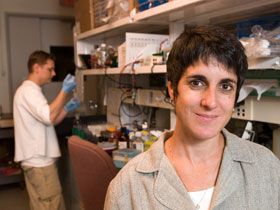  |
| HOME | THIS ISSUE | CALENDAR | GRANTS | BACK ISSUES | < BACK | NEXT > |
Neuroscientist’s research may help limit effects of strokesby Pat Keefe - September 19, 2005 |
||||
|
Sandra Hewett never knew her grandfather, who died of a stroke. In 1998, her mother suffered a stroke that left her physically disabled. Hewett, an associate professor of neuroscience, is now working to determine the cellular and molecular mechanisms of central nervous system injury during strokes. When a stroke occurs, the flow of blood to a particular area of the brain is disrupted and ceases. Brain cells affected by the blockage die. The lack of blood spells death for the cells in the central nervous system, because the blood supply is their sole source of oxygen and nutrients. But a larger section of cells surrounding that area are at risk, too. These are the cells in the penumbra (adjacent areas) of the stroke – what Hewett calls “the walking wounded.” They’re at risk of dying – and increasing the severity of the stroke’s aftermath – because of their proximity to the stroke site. Inflammation and chemical reactions that overexcite the cells contribute to the subsequent cell death. Turn off the inflammation and you preserve the cells in the penumbra and limit the effects of the stroke. Hewett says investigators in the field of neuroscience are exploring diseases of the brain – neurodegenerative disease and stroke – “with the hopes of determining the pathways of destruction against which to devise pharmacological interventions.” The specific enzymes Hewett is investigating, nitric oxide synthase (NOS) and cyclooxygenase (COX), are both present in the cells of the stroke’s penumbra. Both enzymes have been shown to contribute to the progression of neurodegeneration that occurs after stroke. By altering these enzymatic pathways, she’s obtained positive results in tissue culture and in animal models that someday could promise effective treatments to limit the devastating effects of strokes. “Sandra simply bubbles over with enthusiasm about science, whether doing her own lab work, teaching students one-on-one, or in a larger lecture setting,” says Richard Mains, professor and head of the Department of Neuroscience. “Her work on stroke models and the interactions of glial cells and neurons has a very obvious clinical-human impact. In addition, she serves as the current director of the Neuroscience Graduate Program, a role well suited to her enthusiasm, scientific breadth and people skills.” Hewett, who has a doctorate in pharmacology, was interested early in her career in becoming a physician. But after a couple of undergraduate lab fellowships, she opted for the bench rather than the bedside.
She and her husband, Dr. James Hewett, her longtime collaborator, have one of only a half-dozen Small Business Innovation Research (SBIR) grants at the Health Center. An SBIR grant provides funds for early-stage research and development, with the ultimate goal of translating basic research into clinical trials. That opportunity knocked on her podium, so to speak, after a talk she delivered at Albert Einstein College in New York at a conference designed to highlight the commonalities between cancer and Alzheimer’s disease. After the talk, a member of the audience introduced himself as the vice president of Onconova Therapeutics, a privately held New Jersey company specializing in cancer therapy; he asked whether she’d be interested in collaborating with them to test their products in her stroke models. Hewett later wrote a grant in collaboration with Onconova, which has been approved for federal SBIR funding. With a traditional RO1 NIH grant, a Donaghue Investigator Program grant, an established investigator award from the American Heart Association, and the SBIR grant, the funding is in place to continue the lab’s work. Hewett is optimistic but realistic. “The work will take years,” she says. “We’ve made progress and it’s very exciting, but we won’t have an answer or a cure tomorrow.” She’s hopeful that the work she is doing today will give the grandparents of the future a better chance of knowing their grandchildren – and not missing out on that opportunity because of stroke. Editor’s note: This article ran last week with an incorrect photo. We regret the error. |
| ADVANCE HOME UCONN HOME |

